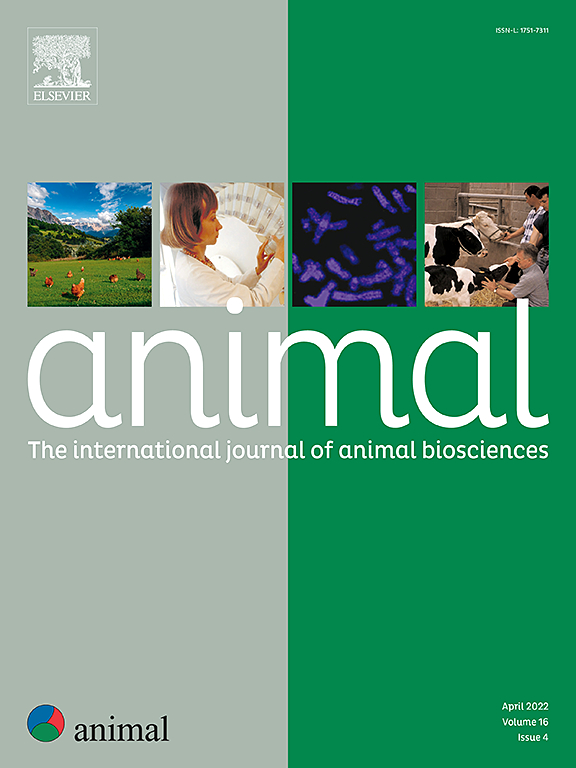Effect of phosphorus and calcium precision feeding on reproductive performances and mineral status in gestating sows
IF 4.2
2区 农林科学
Q1 AGRICULTURE, DAIRY & ANIMAL SCIENCE
引用次数: 0
Abstract
Precision feeding can enhance amino acid utilization efficiency in swine, but precision phosphorus (P) feeding on gestating sows has not yet been tested. Therefore, the aim of the study was to evaluate the effects of a P and calcium (Ca) precision feeding strategy during gestation on the phosphocalcic status and performance of sows compared with constant dietary contents over two gestation cycles. A total of 120 sows were monitored over two consecutive cycles (C1 and C2) to study the effects of three dietary treatments: Canadian (CAN; 0.32% digestible P; 0.83% Ca), European (EU; 0.25% digestible P; 0.68% Ca), and precision feeding (PR; 0.15–0.32% digestible P; 0.46–0.83% Ca). Phosphocalcic status was studied during two cycles on days 30 (d30) and 90 (d90) or 110 postweaning (d110) by the 24-h total urine collection using the catheter method and blood analyses. The BW and backfat thickness were measured at mating, on d110, and at weaning. The only performance trait affected by the dietary treatments was a higher backfat thickness on d110 in sows fed PR compared to those one of EU and CAN (P < 0.05). Lactation performances were similar across all treatments. Dietary treatments, stage of gestation, and cycle did not influence urinary Ca excretion. A three-way interaction was observed for urinary P excretion and urinary Ca:P ratio (Treatment × Stage × Cycle, P < 0.05). The PR sows excreted more P in urine than the CAN sows, although the CAN sows were fed a higher P amount. High P losses were associated with a low Ca:P ratio (less than 0.5), indicating a lack of Ca supply to retained P. At d30 of C2, EU sows excreted more P than CAN sows (P < 0.05) and numerically more than PR sows, likely due to insufficient Ca supply to retain P. On d90 of C2, PR sows still lack Ca (urinary Ca:P ratio less than 0.5). This study highlights the importance of controlling the digestible Ca:P ratio when applying precision feeding in order to obtain maximal dietary P efficiency. This ratio was probably too low in the PR feeding treatment. Monitoring across multiple cycles is essential to validate this strategy and support its adoption on commercial farms.
磷钙精确饲喂对妊娠母猪繁殖性能和矿物质状况的影响。
精细化饲喂能提高猪对氨基酸的利用效率,但精细化磷饲喂在妊娠母猪上的试验尚未见。因此,本研究旨在评估妊娠期磷钙(Ca)精确饲喂策略对母猪磷钙状态和生产性能的影响,并与两个妊娠周期内固定饲粮含量的饲喂策略进行比较。采用连续2个周期(C1和C2)对120头母猪进行监测,研究加拿大(CAN; 0.32%可消化磷;0.83%钙)、欧洲(EU; 0.25%可消化磷;0.68%钙)和精密饲喂(PR; 0.15 ~ 0.32%可消化磷;0.46 ~ 0.83%钙)3种饲粮处理的效果。在断奶后第30天(d30)、第90天(d90)或第110天(d110)两个周期内,通过24小时尿管收集和血液分析来研究磷钙状态。分别在配种、第110天和断奶时测量体重和背膘厚度。受日粮处理影响的唯一生产性状是PR饲粮母猪的d110背膘厚度高于EU和CAN饲粮(P < 0.05)
本文章由计算机程序翻译,如有差异,请以英文原文为准。
求助全文
约1分钟内获得全文
求助全文
来源期刊

Animal
农林科学-奶制品与动物科学
CiteScore
7.50
自引率
2.80%
发文量
246
审稿时长
3 months
期刊介绍:
Editorial board
animal attracts the best research in animal biology and animal systems from across the spectrum of the agricultural, biomedical, and environmental sciences. It is the central element in an exciting collaboration between the British Society of Animal Science (BSAS), Institut National de la Recherche Agronomique (INRA) and the European Federation of Animal Science (EAAP) and represents a merging of three scientific journals: Animal Science; Animal Research; Reproduction, Nutrition, Development. animal publishes original cutting-edge research, ''hot'' topics and horizon-scanning reviews on animal-related aspects of the life sciences at the molecular, cellular, organ, whole animal and production system levels. The main subject areas include: breeding and genetics; nutrition; physiology and functional biology of systems; behaviour, health and welfare; farming systems, environmental impact and climate change; product quality, human health and well-being. Animal models and papers dealing with the integration of research between these topics and their impact on the environment and people are particularly welcome.
 求助内容:
求助内容: 应助结果提醒方式:
应助结果提醒方式:


